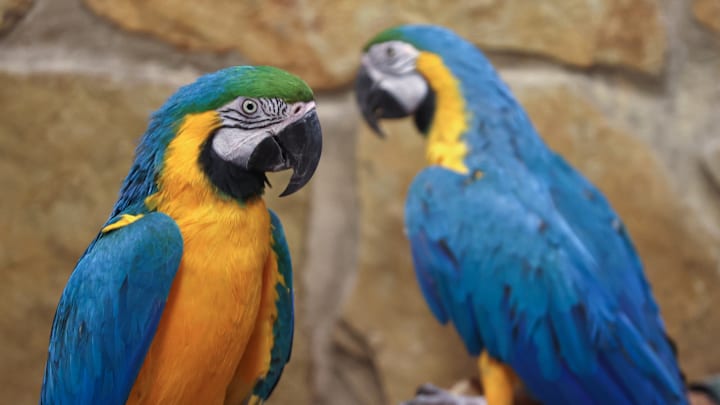For their size, some birds have remarkably long lifespans. They live at least three times as long as mammals of the same size, despite shared qualities such as a high body temperature, high metabolism, and high glucose levels that tend to shorten longevity. But exactly how long do birds live?
- The Longest-Living Birds
- Factors That Affect Birds’ Lifespans
- How Scientists Tell a Bird’s Age
- Cheat Sheet of Long-Lived Birds
A short answer is five to 10 years. But finding an average isn’t straightforward because birds, or Aves, are a taxonomic class comprised of over 11,000 species, all with widely varying lifespans.
The Longest-Living Birds
Parrots, flamingos, petrels, and shearwaters are thought to be the longest-living orders of Aves. Species within these groups often live over 30 years. The longest-living individual bird recorded in the wild is a Laysan albatross named Wisdom, found in the Midway Atoll National Wildlife Refuge in Hawaii, who turned 73 in 2023. Other long-living bird species include pink cockatoos and Andean condors, which have abnormally long life spans within their taxonomic families.

Birds with some of the shortest lifespans include perching birds, grebes, and woodpeckers. The ruby-throated hummingbird has the shortest lifespan of three to five years, which is still a relatively long time for such a tiny animal.
Factors That Affect Birds’ Lifespans
A general rule of thumb for any animal species is that the bigger it is, the longer it lives . This effect is particularly strong for birds and bony fishes. As well as living longer, larger birds tend to have fewer natural predators and take longer to develop.
There are some glaring exceptions to this rule. Hummingbirds, for example, are among the smallest birds, and yet some species can live up to up to 14 years in the wild. On the other end of the size scale, ostriches, the world’s largest species of bird, can live for 70 years in captivity, but they usually live for 30 or 40 years in the wild due to natural predators.
Perhaps a more surprising factor in longevity is climate: Tropical birds live “slow” lives, which include longer lifespans, slower metabolisms, slower growth, and fewer offspring per clutch. Temperate birds, on the other hand, seem to live fast and die fast. Scientists find that tropical birds are also more resistant to oxidative stress, which can harm cell tissues and overall health.

A tropical lifestyle is part of the reason parrots live so long. Another is their high cognitive ability. Other lifestyle factors promoting longevity include social behavior that provides safety in numbers and a vegetarian or seed-based diet.
Scientists have also found that telomeres—protective structures on the ends of chromosomes—can predict health and lifespan in the animal kingdom. Shorter telomeres indicate a shorter life expectancy. Interestingly, migrating birds have significantly shorter telomeres than non-migrating birds, which scientists believe is due to the stress of migration.
But the main reason for the incredible longevity of birds may be much simpler and visible to the eye: They can fly. Flying species live up to four times longer than similar-sized animals that cannot fly, primarily because they can escape the clutches of predators more easily.
How Scientists Tell a Bird’s Age
Scientists can determine the age of mammals by looking at the wear and tear of their teeth, horns, or jaws. You can even tell a whale’s age by its build-up of earwax. Birds are a much more difficult case. Few in the wild even reach their potential lifespan due to death by accident or predators.
One of the most established methods is banding, or ringing, which involves putting a metal or colored band around the bird’s ankle. This method is good for estimating longevity potential but is more commonly used to track the movement and migration of birds. The Institute for Bird Populations has been running a banding program called MAPS since 1989 and collecting valuable data on bird populations.

Physical characteristics, such as the condition of feathers, can be used to determine the early life stages of birds. Feathers are easier to analyze on larger birds such as vultures, which show more gaps in their wings with age. Juvenile birds have a distinctive first set of feathers called juvenile plumage which can often look fluffy and baggy, like clothes which are a size too big [PDF]. Adult plumage, on the other hand, can look much scruffier.
It’s even possible to determine the age of young owls by the color of their feathers under UV light. Many owl species’ feathers contain porphyrins, a pigment that breaks down with time and looks fluorescent pink under UV light.
A failsafe method for calculating the age of birds still eludes scientists, but research continues into their extraordinary longevity, perhaps in the hope of uncovering some tips for us (beyond growing wings).
Cheat Sheet of Long-Lived Birds
Birds | Order | Estimated Life Expectancy |
|---|---|---|
Condors (specifically Andean Condors) | Cathartiformes | 40-50 years |
Ostriches | Struthioniformes | 30-40 years |
Parrots | Psittaciformes | 20-30 years |
Flamingos | Phoenicopteriformes | 20-30 years |
Petrels and Shearwaters | Procellariiformes | 15-30 years |
Hummingbirds | Apodiformes | 3-14 years |
Read More Stories About Birds:
